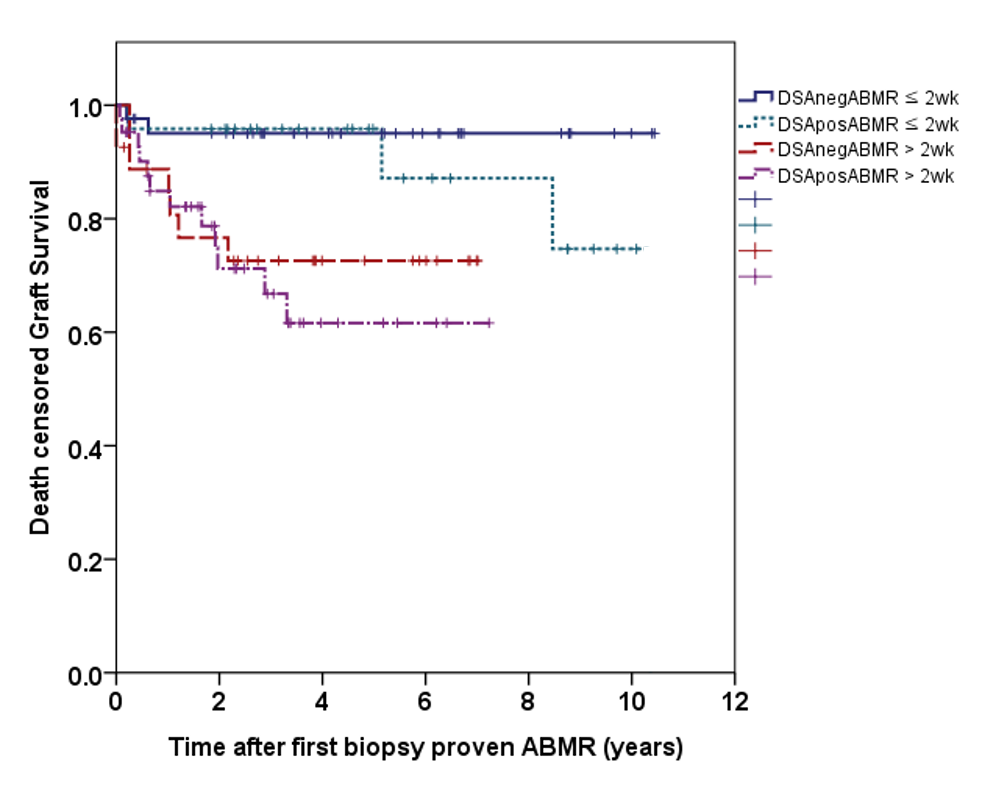Graft Outcomes of Antibody Mediated Rejection without Donor Specific Anti – HLA Antibodies After Kidney Transplantation
Seoul National University Hospital, Seoul, Korea, Republic of
Meeting: 2021 American Transplant Congress
Abstract number: 1032
Keywords: Antibodies, Kidney transplantation, Rejection
Topic: Clinical Science » Kidney » Kidney Acute Antibody Mediated Rejection
Session Information
Session Name: Kidney Acute Antibody Mediated Rejection
Session Type: Poster Abstract
Session Date & Time: None. Available on demand.
Location: Virtual
*Purpose: The aim of this study was to investigate graft outcomes based on the presence of donor-specific anti-HLA antibodies (DSA) and the time of diagnosis in recipients with biopsy proven antibody-mediated rejection (ABMR) after kidney transplantation.
*Methods: Data were collected retrospectively for 136 recipients with histological ABMR after kidney transplantation between January 2010 and December 2018 in Seoul National University Hospital. We compared the graft outcome between the group of ABMR without anti-HLA DSA (DSAnegABMR) and the ABMR with anti-HLA DSA (DSAposABMR). In addition, subgroup analysis was performed for the diagnosis time (within 2 weeks or after 2 weeks) of ABMR after kidney transplantation.
*Results: Of a total of 136 recipients with biopsy-proven ABMR, 67 (49.3%) were DSAposABMR, and 69 (50.7%) were DSAnegABMR. The mean time to ABMR histologic diagnosis after kidney transplantation was 0.99 ± 1.93 years and 2.17 ± 2.35 years In the DSAnegABMR group and the DSAposABMR group, respectively (p = 0.002). The mean fluorescence intensity (MFI) of DSAposABMR was 8276 ± 8130. Although there was no statistically significant difference (p = 0.077), the DSAnegABMR group tended to have a superior graft survival rate compared to the DSAposABMR group. The estimated glomerular filtration rate (eGFR) level was significantly higher in DSAnegABMR at the time of ABMR diagnosis (DSAnegABMR, 48.62 ± 30.60 mL/min/1.73m2; DSAposABMR, 38.78 ± 22.99 mL/min/1.73m2; p = 0.036) and 1 year after diagnosis (DSAnegABMR, 53.85 ± 23.22 mL/min/1.73m2; DSAposABMR, 42.83 ± 21.29 mL/min/1.73m2; p = 0.007). In the subgroup analysis of DSAnegABMR, ABMR diagnosed within 2 weeks after kidney transplantation had a graft survival rate superior to ABMR diagnosed after 2 weeks or more (p = 0.011). The subgroup analysis of DSAposABMR also showed a similar pattern (p = 0.016).
*Conclusions: Our data demonstrate that DSAnegABMR diagnosed within 2 weeks after kidney transplantation had a superior graft survival rate.
To cite this abstract in AMA style:
Ko H, Min S, Han A, Ahn S, Chung CT, Kim H, Choi K, Min S, Kang H, Ha J. Graft Outcomes of Antibody Mediated Rejection without Donor Specific Anti – HLA Antibodies After Kidney Transplantation [abstract]. Am J Transplant. 2021; 21 (suppl 3). https://atcmeetingabstracts.com/abstract/graft-outcomes-of-antibody-mediated-rejection-without-donor-specific-anti-hla-antibodies-after-kidney-transplantation/. Accessed July 14, 2025.« Back to 2021 American Transplant Congress

